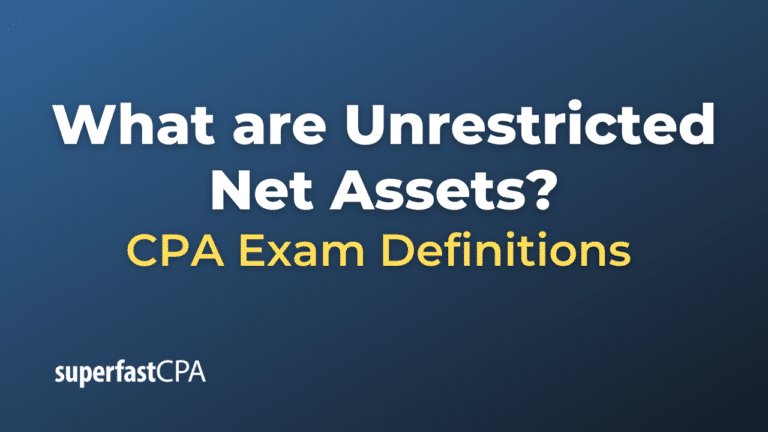
Unfortunately, unless your organization can generate a lot of earned income, or find donors to fund operating deficits, it may already be too late. Situations like this are very difficult to pull out of, but can be prevented by monitoring Readily Available Net Assets along the way. The detail in the general ledger accounts will always be available for management’s use. However, the account balances will be combined into a few amounts that are presented in the financial statements and IRS Form 990.
Statement of Cash Flows
Navigating the accounting standards for restricted net assets is a fundamental aspect of nonprofit financial management. These standards ensure that organizations accurately report their financial position and adhere to donor restrictions. Permanently restricted net assets are a vital component of a nonprofit organization’s financial structure. These assets are funds that have been donated to the organization with specific restrictions that they must be maintained in perpetuity. Instead, they are set aside for specific programs, projects, or initiatives that align with the donor’s intentions. Accurate journal entries are fundamental to managing the release of net assets from restrictions.
Net Assets vs. Equity for Nonprofits
- Marrying an eclectic interest in how things work with other market experience to create a cross pollination of solutions and ideas is a joy for me.
- They are divided between without donor restrictions category and with donor restrictions category.
- Net assets refer to the disparity between what a nonprofit organization owns and owes.
- This can lead to a noticeable increase in total revenues, providing a more comprehensive view of the organization’s financial performance.
- It is important to note that nonprofits do not have owner’s equity or retained earnings like for-profit businesses.
Permanently restricted net assets are funds that donors have designated to be maintained in perpetuity. These assets are often part of an endowment, where the principal amount is invested, and only the income generated from the investment can be used for specific purposes. For instance, a donor might establish a permanent endowment to support a nonprofit’s educational programs, with the stipulation that only the interest or dividends earned be spent.
What is an Income and Expenditure Account? (Explained)
Net assets play a crucial role in the financial health and sustainability of nonprofit organizations. Unlike for-profit businesses, nonprofits do not have owner’s equity or retained earnings. Instead, the difference between what the organization owns and owes is referred to as net assets. These assets how to calculate unrestricted net assets represent the organization’s financial resources that can be used to support its mission and programs. Temporarily restricted net assets are funds that donors have earmarked for specific purposes or projects, with the expectation that the restrictions will be lifted once certain conditions are met.

The Role of Net Assets in Financial Reporting
Another benefit of having unrestricted net assets is that it can help to improve a company’s credit rating. This is because creditors see that the company has a cushion of assets that it can tap into if necessary, making them more likely to extend credit to the company. In conclusion, unrestricted net assets give companies a great deal of flexibility and opportunity, making them an essential part of any well-run business.
Dive deeper into restricted funds with our FREE course!
If you find that you don’t have enough unrestricted revenue for all of your expenses, it’s likely time to look for ways to cut costs or revisit your fundraising predictions to see if it’s possible to earn more. Their support and engagement contribute to the sustainability and success of nonprofit organizations. In the Statement of Financial Position, you will find the total assets, which include both tangible and intangible resources owned by the organization. On the other hand, liabilities represent the organization’s debts and obligations, such as loans, accounts payable, and accrued expenses.
Nonprofits typically use financial ratio analysis to help them measure their overall financial health when benchmarked against similar organizations as well as past financial performance. Two key ratios are Months of Cash and Months of Liquid Unrestricted Net Assets (LUNA). Having months of cash on hand is important, but having unrestricted cash available is essential because it allows an organization to meet its monthly obligations such as rent, payroll and utilities. It’s possible for fixed assets to have donor restrictions, for example a building that can only be used for a specific purpose, but in this example fixed assets are not restricted. Even if fixed assets are unrestricted, though, they are still not cash nor are they usually easily converted to cash (liquid).
It’s essential for stakeholders to carefully review the Statement of Financial Position to assess the nonprofit’s financial stability and make informed decisions. By understanding the organization’s assets, liabilities, and net assets, stakeholders can evaluate its ability to fulfill its mission and sustain its operations. It shows the difference between the total assets and liabilities, indicating the organization’s overall financial position. Net assets are further broken down into different categories, including net assets with and without donor restrictions. This breakdown provides insights into the availability and restrictions placed on the organization’s resources.



